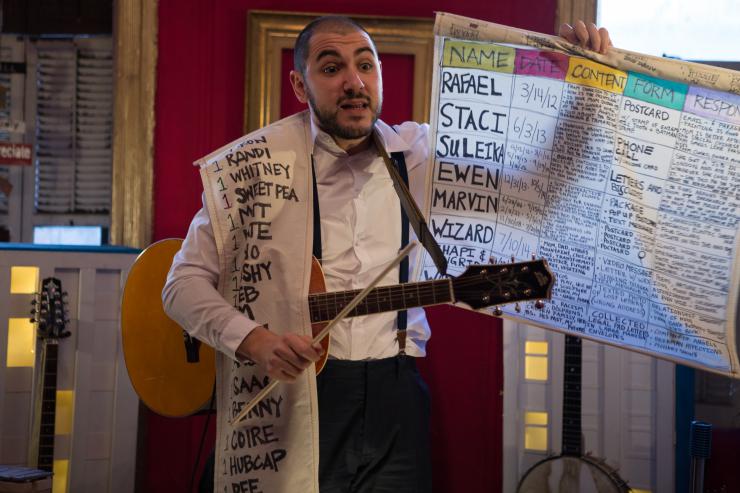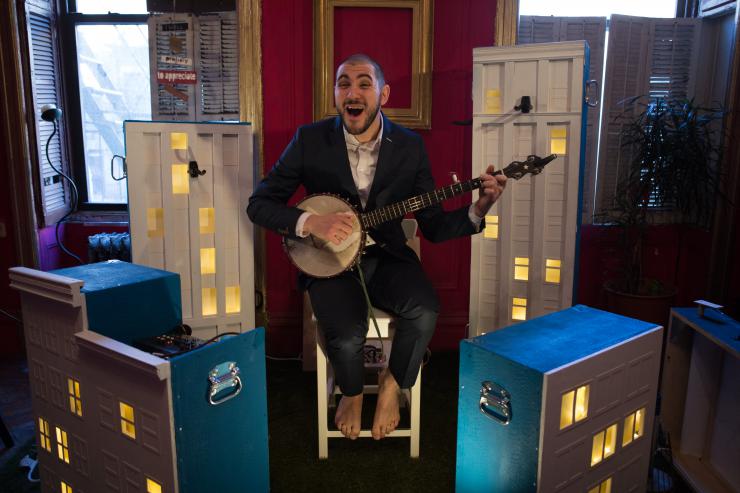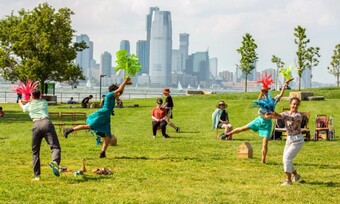I Fall in Love All the Time
It’s not often I get to do any more than surreptitiously peek through the curtains of opulent Brooklyn Heights brownstones as I’m passing by. I imagine that if I ever had cause to actually go into one it would be for buttoned up cocktails and stilted conversation, riding on a friend’s coattails as a plus one for a fundraiser, or as a hired coat-check girl, or as a bartender for a pearls-and-wine-filled birthday party. So while I knew Gideon Irving was performing his show, Living Here: a map of songs, in a different New York City living room every night, the lush, long, tastefully decorated space I found myself in last week was not the living room I expected.
The little research I had done about Irving’s life and work left me with images of a scrappy sweetheart on rollerblades pushing a modified grocery cart to an apartment across town, belting out songs in an arresting voice that would be decidedly unwelcome at a cocktail party, and quickly packing up his several instruments, strapping on his skates and heading to the next show. It has been four years of balladeering for Irving, who, via rollerblades, bicycle, or car, has brought his “Stove Top Folk” one or two-man shows to over 300 homes across the U.S. and New Zealand. Living Here is his newest effort, commissioned by and developed in collaboration with the Foundry Theatre.

Now in its twentieth year, The Foundry is committed to the relevancy of live theatre by constantly investigating and redefining what the art form looks like. The company works with social justice organizations and runs an ongoing Audience Ambassadors Program in an attempt to build a theatregoing audience truly representative of New York City. This dedication to outreach served The Foundry well in the lead up to Living Here, which required finding forty-five different homes, across all five boroughs, to serve as the stages for its run.
Irving isn’t interested in climbing a ladder to stardom; he’s interested in meeting as many people as he can. It’s more than putting on a show, he says, it’s a performance practice and a lifestyle.
If I had been worried about what the big Brooklyn Heights house represented, I was quickly reassured. “I want to be invited everywhere,” says Irving in his opening monologue, “and by everywhere I don’t mean Paris and London. I mean…caves, and pagodas, and straw yurts in fields behind waterfalls and Norwegian islands everywhere.” He was wearing a suit but had bare feet, and his open, polite demeanor was quickly eclipsed in performance by high octane, unbridled enthusiasm. The opening of the show describes, with help from Adam Rigg's scrolling cranky, a utopian future in which “home shows” are commonplace, where eventually locked doors will be a rarity, and roving bands of musicians will need only to choose a house to fill with song. The show’s set, simple, tall boxes painted white and outfitted by Tavish Miller with lit windows, could be seen as a gleaming everycity, and indeed during the show each building is opened to reveal a new instrument. Irving isn’t interested in climbing a ladder to stardom; he’s interested in meeting as many people as he can. It’s more than putting on a show, he says, it’s a performance practice and a lifestyle.
The life of a wandering musical troubadour has unique characteristics, some of which may seem inscrutable from the outside. Wouldn’t Gideon Irving like to settle down, to have a family, to fall in love? “I fall in love all the time,” says Gideon-as-Gideon in Living Here. This sentiment could be a thesis statement for the show, which is a tapestry of songs and anecdotes about Irving’s travels, and a celebration of the characters he meets along the way. Previous home shows have not been as introspective, and the Living Here collaboration was open-ended from the start. “We never set out to make a piece about me, but in accumulating material we kept gravitating towards the stuff from the road and performing.” Irving wrote to me in an email, “That is just where we ended up.” Luckily, a show about this guy is also a show about surprising potato statistics, acclaimed polka accordionists, and ancient snails.

Irving’s collaboration with The Foundry has lent his life and times the sheen of performance, but maybe what was giving the experience a seeing-a-unicorn type quality for me was the knowledge that his life and his art are one and the same. How many bona fide itinerant songster-storytellers do we meet in our lives? I felt myself wanting to see beyond the autobiographical patina because in most of Irving’s work an audience isn’t an audience; they are the people feeding him breakfast. I couldn’t shake the feeling that I was one step removed, that I was hearing about the story when I wanted to be a part of the story. I felt the most connected at the end of the show when we had the opportunity to write our own names and contact information (or our friends’) on a map of the country or the world, Irving’s primary method of finding hosts.
How many bona fide itinerant songster-storytellers do we meet in our lives?
The commission from The Foundry has necessarily created shifts in Irving’s experience of creating and performing. According to Gideon, travelling from home to home in this day and age requires “a mountain of administrative duties,” the burden of which has been mostly lifted this time around,
This show with The Foundry allowed me to spend my time making and that has been a wonderful experience…the one thing I've been missing this time around is staying with my hosts each night. I always want a bit more time with them.
Collaborating with a creative team (Melanie Joseph and Kate Attwell, not to mention designers, a stage manager, and interns) was “as challenging as it is worthwhile. A lot of ego to be put aside, a lot of breath to be breathed and a lot of listening.”
The importance of endurance, which has typically been a major aspect of Irving’s work and life, has begun to fade as shows become larger and more demanding. Biking eleven hours in the rain over a mountain range pulling 200lbs of instruments to play a show for five people is not currently par for the course, as it once was. If you happen to miss him in a local living room this time around, though, don’t worry,
I can't wait to tour through homes on bike again, with a new updated more maneuverable cart and blades, on horseback across the U.S. and New Zealand, on sailboat through water towns. These are all very much plans in the works that will take years to achieve, as I know little about horses and sailing.
Living Here: a map of songs by Gideon Irving is now playing through May 2nd. Find more information here.







Comments
The article is just the start of the conversation—we want to know what you think about this subject, too! HowlRound is a space for knowledge-sharing, and we welcome spirited, thoughtful, and on-topic dialogue. Find our full comments policy here